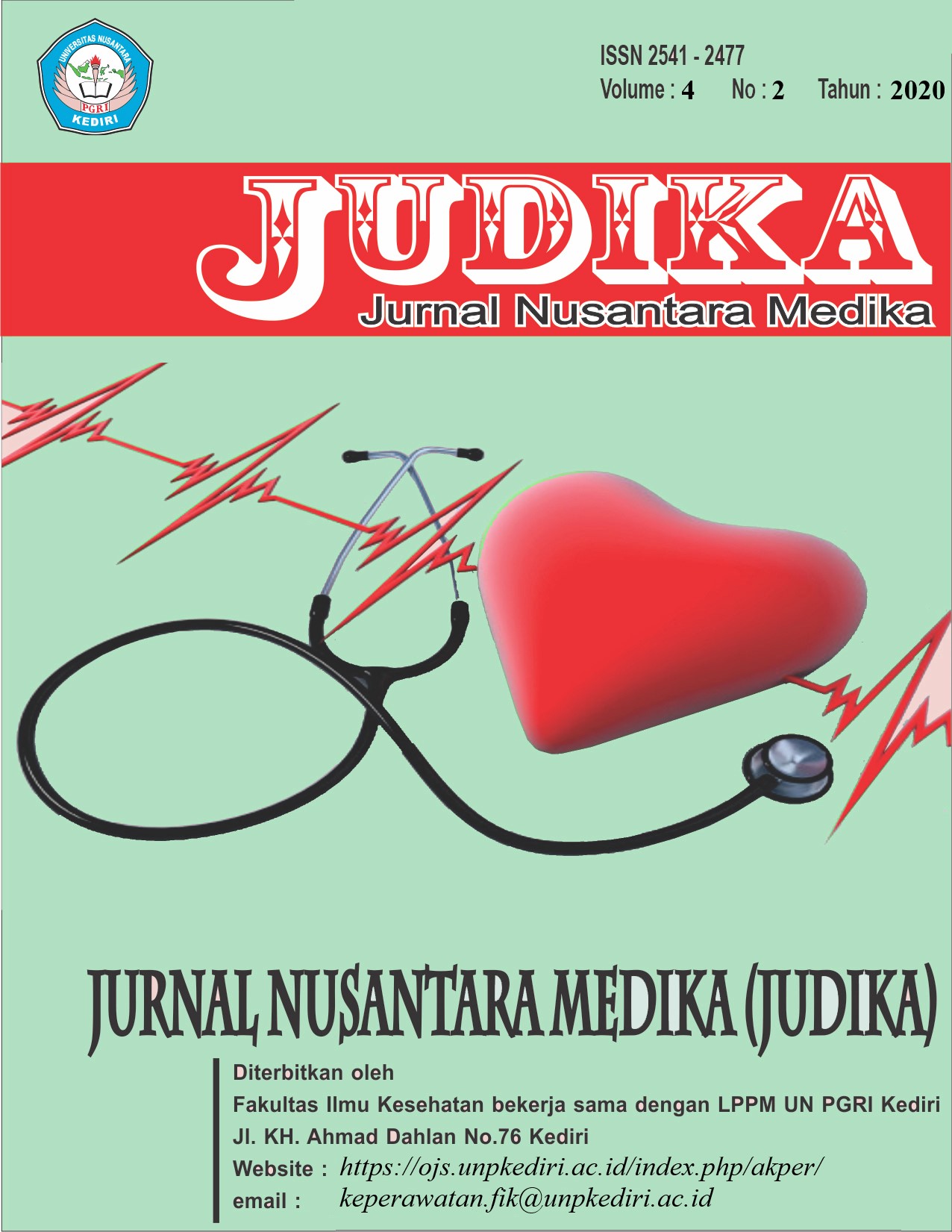Perbedaan Efektifitas Pemberian Yoga dan Kompres Hangat Terhadap Tingkat Nyeri Dismenore Pada Mahasiswa Fakultas Ilmu Kesehatan Universitas Kadiri Tahun 2019
DOI:
https://doi.org/10.29407/judika.v4i2.14864Keywords:
Yoga, Warm Compress, DismenorAbstract
Dismenorrea is a pain during menstruation that interferes with a woman's daily activities and encourages sufferers to have an examination or consultation with a doctor, or come obstetrics. Based on preliminary studies, the number of students experiencing menstrual pain (dysmenorrhea) was 89.1% greater than the number of students who did not experience menstrual pain (dysmenorrhea) of 10.8%. The goal is to analyze the Difference in Effectiveness of Giving Yoga And Warm Compresses to The Level of Dismenor Pain in Students of Faculty of Health Sciences Unversitas Kadiri in 2019. sampling in research using purposive sampling methods. This research is pre experimental. The sample in this study was 32 people. This research was conducted at the Faculty of Health Sciences of Kadiri University in August 2019. Analyze data on comparative hypothesis tests using paired, ratio-shaped data. The study used paired t test and Wilcoxon Signed Rank Test. The results showed there was an influence of Yoga and warm compresses on the decrease in menstrual pain in students of the university's faculty of health sciences kadiri in 2019. Mann-Whitney's different test results showed that p 0.047 < α (0.05) so that H1 received H0 was rejected which meant there was a difference in the effectiveness of Yoga and warm compresses where warm compresses were more effective than Yoga against a decrease in the menstrual pain scale in students of the university's faculty of health sciences kadiri in 2019.
Downloads
References
Andarmoyo,S.(2013). Konsep Dan Proses Perawatan Nyeri. Jogjakarta: Ar-Ruzz.
Anurogo,.D, & Wulandari,A.(2012). Cara Jitu Mengatasi Nyeri Haid. Yogyakarta: Andi.
Dahro, ahmad (2012). Buku Psikologi Kebidanan Analisis Perilaku Wanita Untuk Kesehatan. Salemba medika: Jakarta
Dewi, N.S.(2012). Biologi Reproduksi. Yogyakarta: pustaka rihama.
Erikar lebang, (2015).Yoga Sehari-Hari Untuk Kesehatan. Pustaka Bunda : Jakarta
Gabriel, J.F. (2007). Fisika Kedokteran. Jakarta:EGC.
Judha M. Sudarti dan Fauziah A. (2012). Teori Pengukuran Nyeri Dan Nyeri Persalinan. Yogyakarta. Nuha Medika
Potter & Perry.(2010). Buku Ajar Fundamental Keperawatan. Edisi 4, Jakarta:EGC
Proverawati, A. (2012). Perilaku Hidup Bersih Dan Sehat (PHBS). Yogyakarta: Nuha Medika
Smeltzer & Brenda. (2002). Buku Ajar Keperawatan Medikal Bedah brunner & Sudarth Vol. 1. Jakarta:EGC
Sindhu, P. (2014). Hidup Sehat Dan Seimbang Dengan Yoga. Bandung: Qanita.
Suratini. (2015). Panduan Praktikum Keperawatan Keluarga. STIKES, Aisyiyah Yogyakarta
Wiknjosastro, H. (2009). Ilmu Kebidanan. Jakarta: bina pustaka
Downloads
Published
Issue
Section
License
Authors who publish with this journal agree to the following terms:
- Copyright on any article is retained by the author(s).
- The author grants the journal, right of first publication with the work simultaneously licensed under a Creative Commons Attribution License that allows others to share the work with an acknowledgment of the work’s authorship and initial publication in this journal.
- Authors are able to enter into separate, additional contractual arrangements for the non-exclusive distribution of the journal’s published version of the work (e.g., post it to an institutional repository or publish it in a book), with an acknowledgment of its initial publication in this journal.
- Authors are permitted and encouraged to post their work online (e.g., in institutional repositories or on their website) prior to and during the submission process, as it can lead to productive exchanges, as well as earlier and greater citation of published work.
- The article and any associated published material is distributed under the Creative Commons Attribution-ShareAlike 4.0 International License













